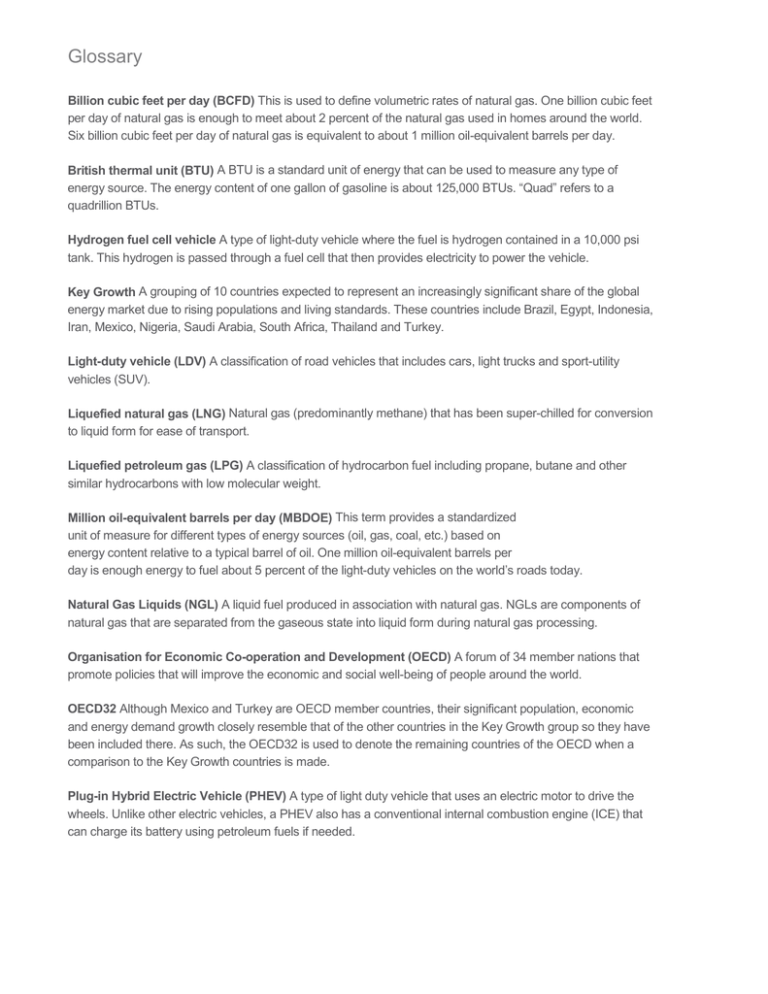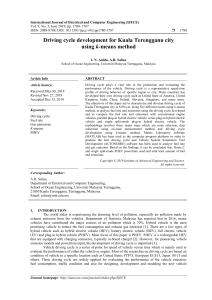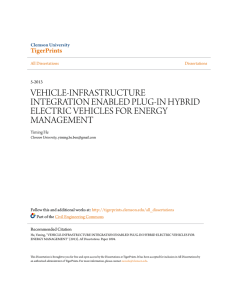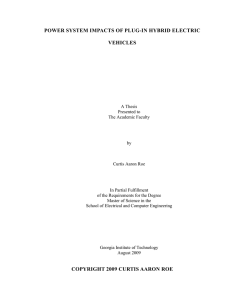Glossary - ExxonMobil
advertisement

Glossary Billion cubic feet per day (BCFD) This is used to define volumetric rates of natural gas. One billion cubic feet per day of natural gas is enough to meet about 2 percent of the natural gas used in homes around the world. Six billion cubic feet per day of natural gas is equivalent to about 1 million oil-equivalent barrels per day. British thermal unit (BTU) A BTU is a standard unit of energy that can be used to measure any type of energy source. The energy content of one gallon of gasoline is about 125,000 BTUs. “Quad” refers to a quadrillion BTUs. Hydrogen fuel cell vehicle A type of light-duty vehicle where the fuel is hydrogen contained in a 10,000 psi tank. This hydrogen is passed through a fuel cell that then provides electricity to power the vehicle. Key Growth A grouping of 10 countries expected to represent an increasingly significant share of the global energy market due to rising populations and living standards. These countries include Brazil, Egypt, Indonesia, Iran, Mexico, Nigeria, Saudi Arabia, South Africa, Thailand and Turkey. Light-duty vehicle (LDV) A classification of road vehicles that includes cars, light trucks and sport-utility vehicles (SUV). Liquefied natural gas (LNG) Natural gas (predominantly methane) that has been super-chilled for conversion to liquid form for ease of transport. Liquefied petroleum gas (LPG) A classification of hydrocarbon fuel including propane, butane and other similar hydrocarbons with low molecular weight. Million oil-equivalent barrels per day (MBDOE) This term provides a standardized unit of measure for different types of energy sources (oil, gas, coal, etc.) based on energy content relative to a typical barrel of oil. One million oil-equivalent barrels per day is enough energy to fuel about 5 percent of the light-duty vehicles on the world’s roads today. Natural Gas Liquids (NGL) A liquid fuel produced in association with natural gas. NGLs are components of natural gas that are separated from the gaseous state into liquid form during natural gas processing. Organisation for Economic Co-operation and Development (OECD) A forum of 34 member nations that promote policies that will improve the economic and social well-being of people around the world. OECD32 Although Mexico and Turkey are OECD member countries, their significant population, economic and energy demand growth closely resemble that of the other countries in the Key Growth group so they have been included there. As such, the OECD32 is used to denote the remaining countries of the OECD when a comparison to the Key Growth countries is made. Plug-in Hybrid Electric Vehicle (PHEV) A type of light duty vehicle that uses an electric motor to drive the wheels. Unlike other electric vehicles, a PHEV also has a conventional internal combustion engine (ICE) that can charge its battery using petroleum fuels if needed. Glossary Primary energy Includes energy in the form of oil, natural gas, coal, nuclear, hydro, geothermal, wind, solar and bioenergy sources (biofuels, municipal solid waste, traditional biomass). It does not include electricity or market heat, which are secondary energy types reflecting conversion/production from primary energy sources. Secondary energy Energy types reflecting the conversion or production of energy from primary energy sources such as electricity produced using natural gas. Watt A unit of electrical power, equal to one joule per second. A 1-gigawatt power plant can meet the electricity demand of more than 500,000 homes in the U.S. (Kilowatt (kW) = 1,000 watts; Gigawatt (GW) = 1,000,000,000 watts; Terawatt (TW) = 1012 watts). 300 terawatt hours is equivalent to about 1 quadrillion BTUs (Quad).




